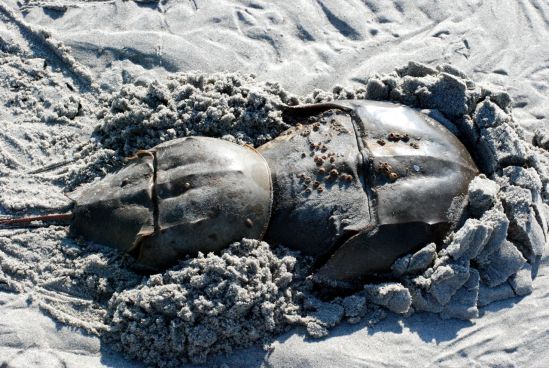 This is the time of year (mid-May to mid-June) when our Horseshoe Crabs come into the shallows to mate, sometimes ending up dead on the beach in the process. The WaPo did a piece on the spectacle a few years ago.
This is the time of year (mid-May to mid-June) when our Horseshoe Crabs come into the shallows to mate, sometimes ending up dead on the beach in the process. The WaPo did a piece on the spectacle a few years ago.
These critters, or ones similar, have been around for 1/2 billion years. The female digs holes in the sand and deposits around 20,000 eggs in each one, which the male then fertilizes. Those eggs are an important shorebird food.
They aren't really crabs: they are closer to trilobites and spiders.
A few Horsehoe Crab facts from this site:
- Despite their size and intimidating appearance, horseshoe crabs are not dangerous.
- A horseshoe crab's tail, while menacing, is not a weapon. Instead, the tail is used to plow the crab through the sand and muck, to act as a rudder, and to right the crab when it accidentally tips over.
- The horseshoe crab's central mouth is surrounded by its legs and while harmless, it is advisable to handle a horseshoe crab with care since you could pinch your fingers between the two parts of its shell while holding it.
- Horseshoe crabs have 2 compound eyes on the top of their shells with a range of about 3 feet. The eyes are used for locating mates.
- Horseshoe crabs can swim upside down in the open ocean using their dozen legs (most with claws) and a flap hiding nearly 200 flattened gills to propel themselves.
- Horseshoe crabs feed mostly at night and burrow for worms and mollusks. They will, however, feed at any time.
- Horseshoe crabs grow by molting and emerge 25 percent larger with each molt. After 16 molts (usually between 9 and 12 years) they will be fully grown adults.
- Horseshoe crab eggs are important food for migratory shore birds that pass over the Delaware Bay during the spring mating season. Fish also eat the juveniles or recent molts.
- In the 1900s, horseshoe crabs were dried for use as fertilizer and poultry food supplements before the advent of artificial fertilizers.
- The medical profession uses an extract from the horseshoe crab's blue, copper-based blood called lysate to test the purity of medicines. Certain properties of the shell have also been used to speed blood clotting and to make absorbable sutures.
A reader sent us this photo from two weeks ago. The male is the smaller one, clinging to the the barnacle-encrusted female:
 �
�


 This is the time of year (mid-May to mid-June) when our Horseshoe Crabs come into the shallows to mate, sometimes ending up dead on the beach in the process. The WaPo
This is the time of year (mid-May to mid-June) when our Horseshoe Crabs come into the shallows to mate, sometimes ending up dead on the beach in the process. The WaPo  �
�